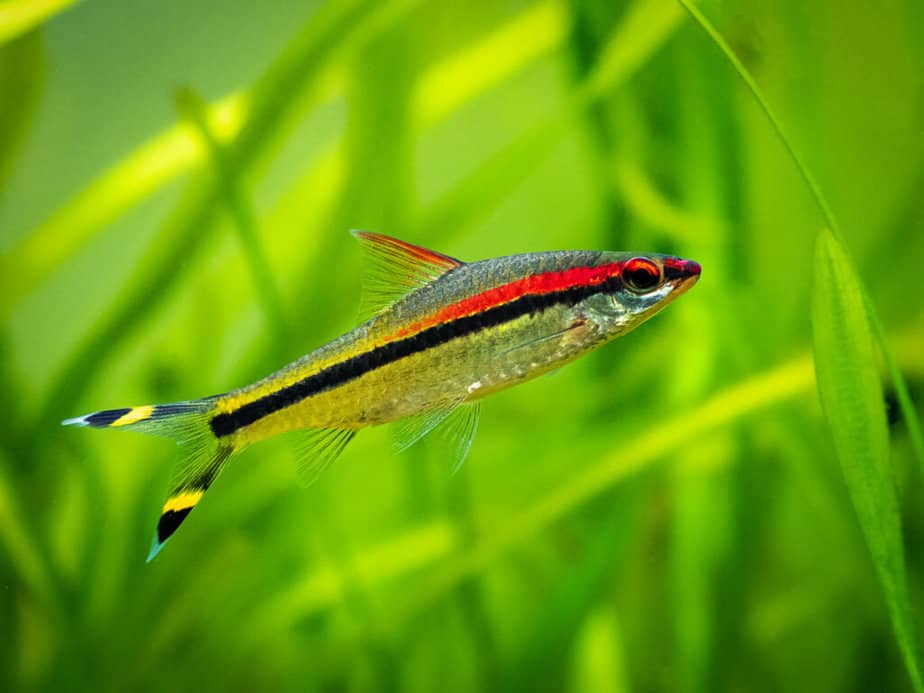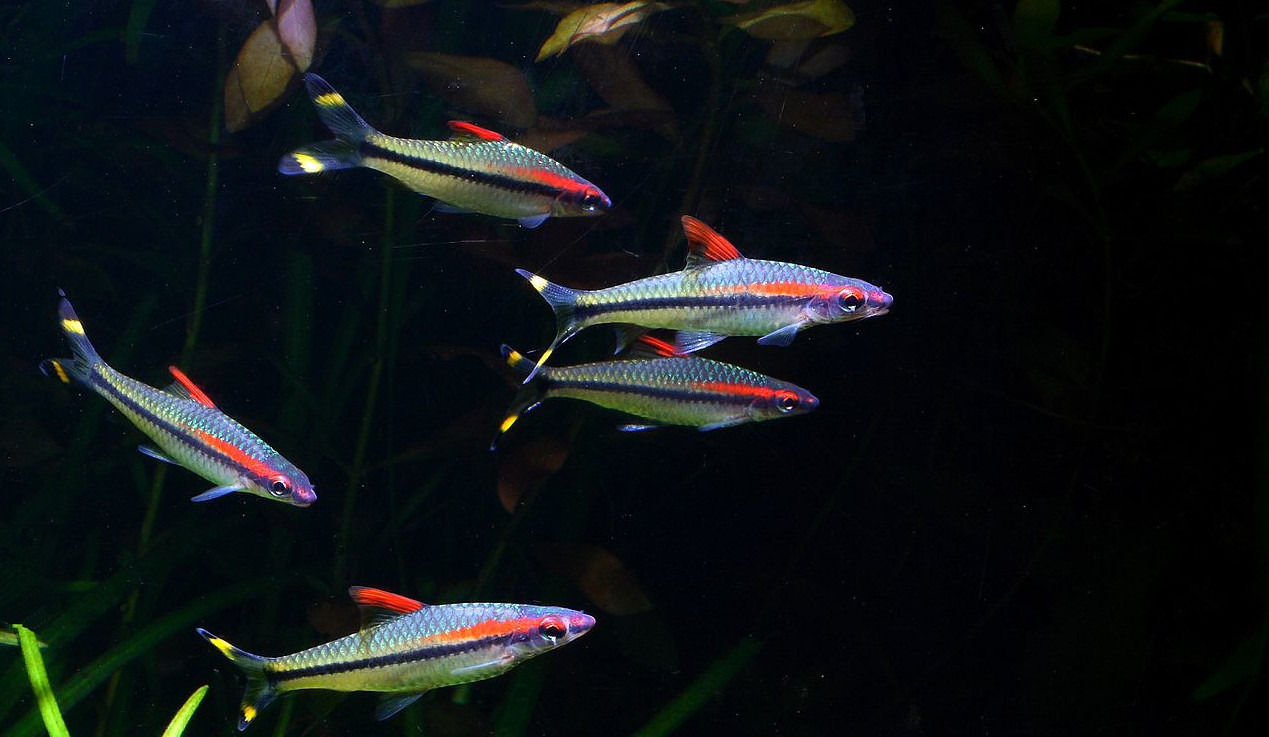Denison Barb
Denison Barb – Sahyadria denisonii, or Denison’s barb, is also known by other names such as Miss Kerala, Red-Line Torpedo Barb, or Roseline Shark. This beautiful new addition to the world of fish collecting, originating from India, is typically displayed in small aquatic schools. It should be noted, though, that the species is endangered in its home country.
- Experience Level: Beginner
- Hardiness: Hardy
- Minimum Tank Size: 55 gal (200 L)
- Maximum Size: 6 inches (15 cm)
- Temperament: Peaceful
- Temperature: 59 – 77° F (15 – 25° C)
- pH Range: 6.5 – 7.5
- Water Hardness: 5 – 25 dGH
- Diet: Omnivore
Table of Contents
Introduction
Size and Appearance
Care Guide
Tank Mates
Diet and Feeding
Breeding
Interestingly, since the halting of wild fish exports, the locally bred Denison Barb population has prospered. As a result, the availability of this species relies more heavily on commercial breeding than the actual demand for the fish, which remains consistently high.
Native to southwest India, the Denison barb inhabits four distinct regions spread across an area spanning 3,000 square miles, encompassing Achankovil, Pamba, and Chaliyar rivers. Their habitat typically comprises of quickly flowing streams, pebbled ponds, and turbulence amidst plentiful vegetation, offering ample hiding places.
Size and Appearance
Aquarists admire the Denison barb – or Roseline barb – for its vibrant hues and playful demeanor. The fish’s body design is typically elongated, reminiscent of a shark with a curved abdomen and supple, see-through pectoral fins.
A Denison barb or Roseline shark typically grows to 6 inches in length, but in most tanks, the fish maintain a more modest size of 3 inches. Under optimal care conditions, the average life cycle for a Denison barb is around 5 years.
Their coloring is a remarkable fusion of silver or gold paired with a vivid half-length red stripe that’s underscored by a black one running along the fish’s body. The dorsal fin mirrors the red stripe, while the tail exhibits an almost black-blue tone adorned with yellow bars on its top and bottom lobes.
Care Guide
- Minimum Tank Size: 55 gal (200 L)
- pH Range: 6.5 – 7.5
- Water Hardness: 5 – 25 dGH
- Temperature: 59 – 77° F (15 – 25° C)
- Lighting: Moderate, diffused lighting
- Substrate: Fine sand/gravel
- Brackish: No
- Water Flow: Weak/Low
- Tank Region: All areas
A Denison Barb is a species that navigates all tank levels, thus making it compatible with various living conditions. These active swimmers require spacious tanks comprising of a variety of niches to explore. A 55-gallon horizontal tank would be the minimum requirement to comfortably house a set of 6 Denison barbs, while a larger group would need a bigger home.
Given their preference for cool, running water high in oxygen content, the Rose Lined shark or Denison barb would benefit from an advanced filtration system and water pump that mimics their natural habitats.
It’s important to note that a Denison barb is particularly responsive to changes in water quality. Hence, weekly water testing and tank cleaning are recommended. Ideally, the water’s pH should hover between 6.5 and 7.5 and possess a hardness in the range of 5 – 25 dH. Regular removal of waste from the tank is a must to maintain optimal living conditions.
Recommended temperature ranges from 59°F to 77°F (15°- 25° C). If the tank houses other fish species that prefer warmer conditions, it would be beneficial to aim for the higher end of the barb’s temperature range using a dedicated water heater.
Health-related issues can occur if the water quality deviates from recommended conditions, with the Ich disease being one possible threat that could potentially prove fatal. Signs of this disease include fuzzy spots on the fish’s body and erratic behavior. Isolating the affected fish and thoroughly cleaning the tank can prevent it from spreading.
An open water tank, devoid of too many elements, might result in the fish losing color and becoming listless. Starting with the usual coral sand or aquarium gravel substrate, firmly rooting groups of plants can give the barb something to actively engage with as it roams the tank.
The Denison barb is notorious for uprooting weakly anchored plants, so care should be taken while selecting and arranging vegetation in the tank. High-light plants such as Pothos, Anubias, Java Fern varieties, or Amazon fern (for larger tanks) are all viable choices. A day/night light cycle timer can maintain a balance in the barb’s activity levels and overall plant health.
In addition to plants, driftwood, rocks, and different shapes can be introduced in the tank, providing ample opportunities for exploration and offering safe zones for potential tank mates.
Tank Mates
Denison Barb or Roseline Shark compatibility depends on the fish population within the tank, the environment within, and the activity levels of the other fish. Generally peaceful, denison barbs can exhibit aggression in populated tanks, especially towards smaller, less assertive species.
Having a tendency to nip at fins, they aren’t suited to share a tank with fish possessing flowy fins. Ideally, they should be paired with similarly sized, active fish and should not cohabitate with excessively aggressive or abnormally large fish.
Feeding Guide
- Diet: Omnivore
- Frequency: Several small feedings per day
- Pellet Foods: Yes
- Flake Foods: Yes
- Live Foods: Yes
- Meat Foods: Yes
- Vegetable Foods: Yes, will often take partly cooked, dark leafy greens
Feeding Denison barb is rather straightforward, given their omnivorous nature. Variety in their diet is recommended to keep them from getting used to one type of food.
Watch out for aggression during meal times. Slow- or floating-feeding varieties should be adopted to ensure all food is consumed before it hits the bottom, ensuring a peaceful feeding environment.
Breeding
By the mid-2000s the Denison barb was on the endangered list, primarily due to overharvesting. Fortunately, dedicated fisheries and professional collectors were successful in breeding them in captivity.
Breeding this species is complex, and most hobbyists may find it challenging. Identifying the sex of mature Denison barbs is a significant hurdle, especially during non-spawning periods. Timing also plays a crucial role. In the wild, these fish breed from October through December, with the timeframe differing across rivers where they naturally live.
The induced breed process includes modifying water chemistry, changing feeding schedules, and sedating fishes, which is not recommended for non-professionals.



